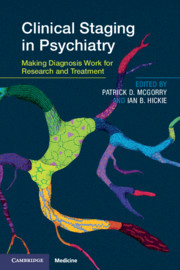Book contents
- Clinical Staging in Psychiatry
- Clinical Staging in Psychiatry
- Copyright page
- Contents
- Contributors
- Foreword
- Acknowledgements
- Section 1 Conceptual and Strategic Issues
- Chapter 1 Diagnosis without Borders
- Chapter 2 Clinical Staging and Its Potential to Enhance Mental Health Care
- Chapter 3 Time for a Change
- Chapter 4 A Moving Target
- Section 2 Progress with Clinical Staging
- Section 3 Novel Treatment Strategies
- Section 4 Novel Treatment Strategies
- Index
- Plate Section (PDF Only)
- References
Chapter 3 - Time for a Change
A More Dynamic Perspective on Psychopathology
from Section 1 - Conceptual and Strategic Issues
Published online by Cambridge University Press: 08 August 2019
- Clinical Staging in Psychiatry
- Clinical Staging in Psychiatry
- Copyright page
- Contents
- Contributors
- Foreword
- Acknowledgements
- Section 1 Conceptual and Strategic Issues
- Chapter 1 Diagnosis without Borders
- Chapter 2 Clinical Staging and Its Potential to Enhance Mental Health Care
- Chapter 3 Time for a Change
- Chapter 4 A Moving Target
- Section 2 Progress with Clinical Staging
- Section 3 Novel Treatment Strategies
- Section 4 Novel Treatment Strategies
- Index
- Plate Section (PDF Only)
- References
Summary
This chapter describes our changing views on psychopathology and our attempts to model it. In particular, it argues how, for a significant step forward in mental health research, we should acknowledge the complex nature of mental illness. We introduce an exciting new paradigm in the field of psychopathology: the network paradigm. We discuss the basics of network theory, its application to psychopathology and some future directions of where this avenue may take us.
- Type
- Chapter
- Information
- Clinical Staging in PsychiatryMaking Diagnosis Work for Research and Treatment, pp. 34 - 66Publisher: Cambridge University PressPrint publication year: 2019



